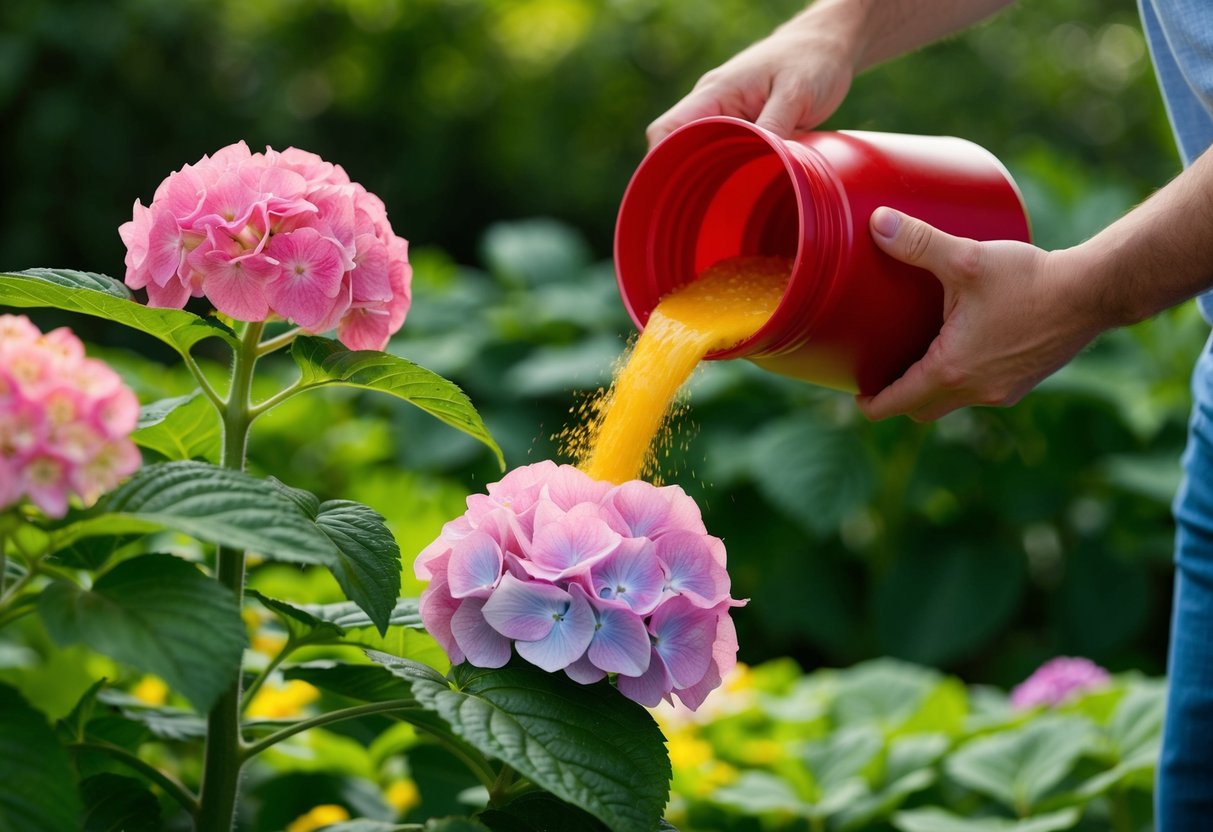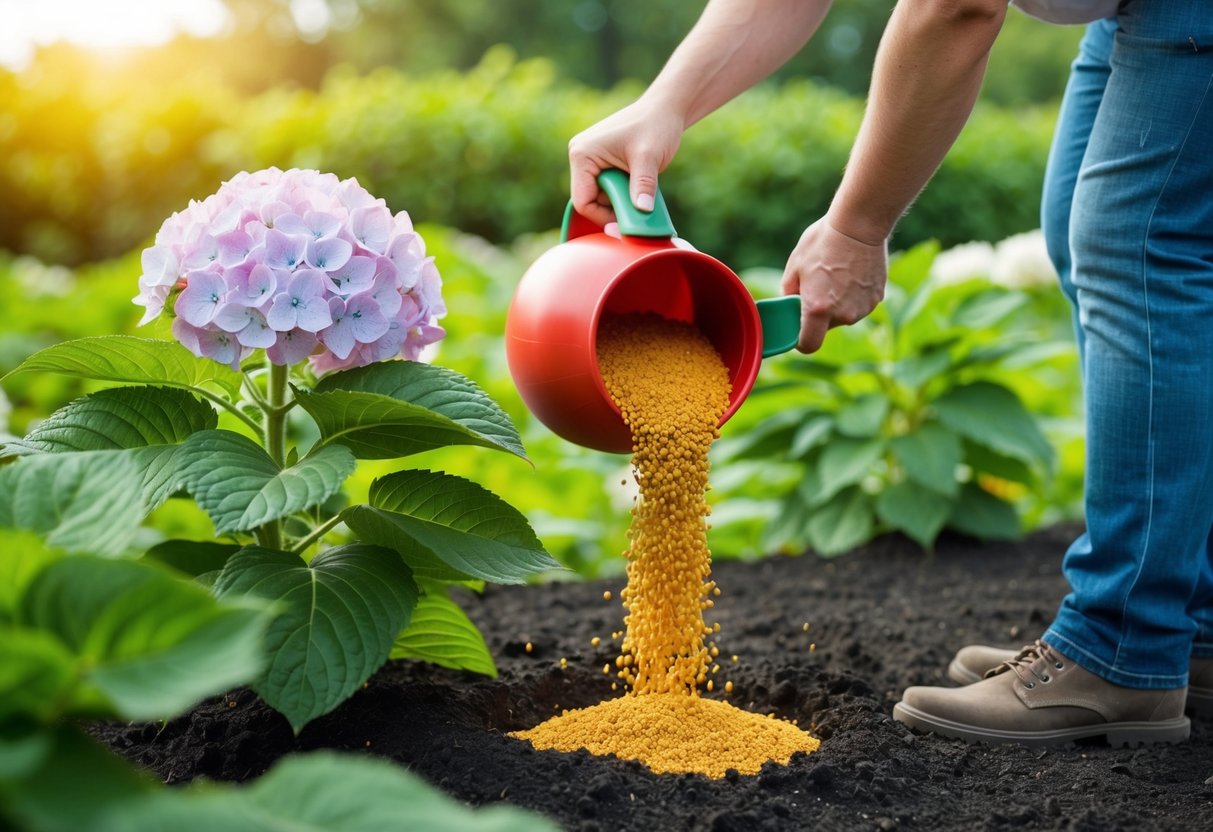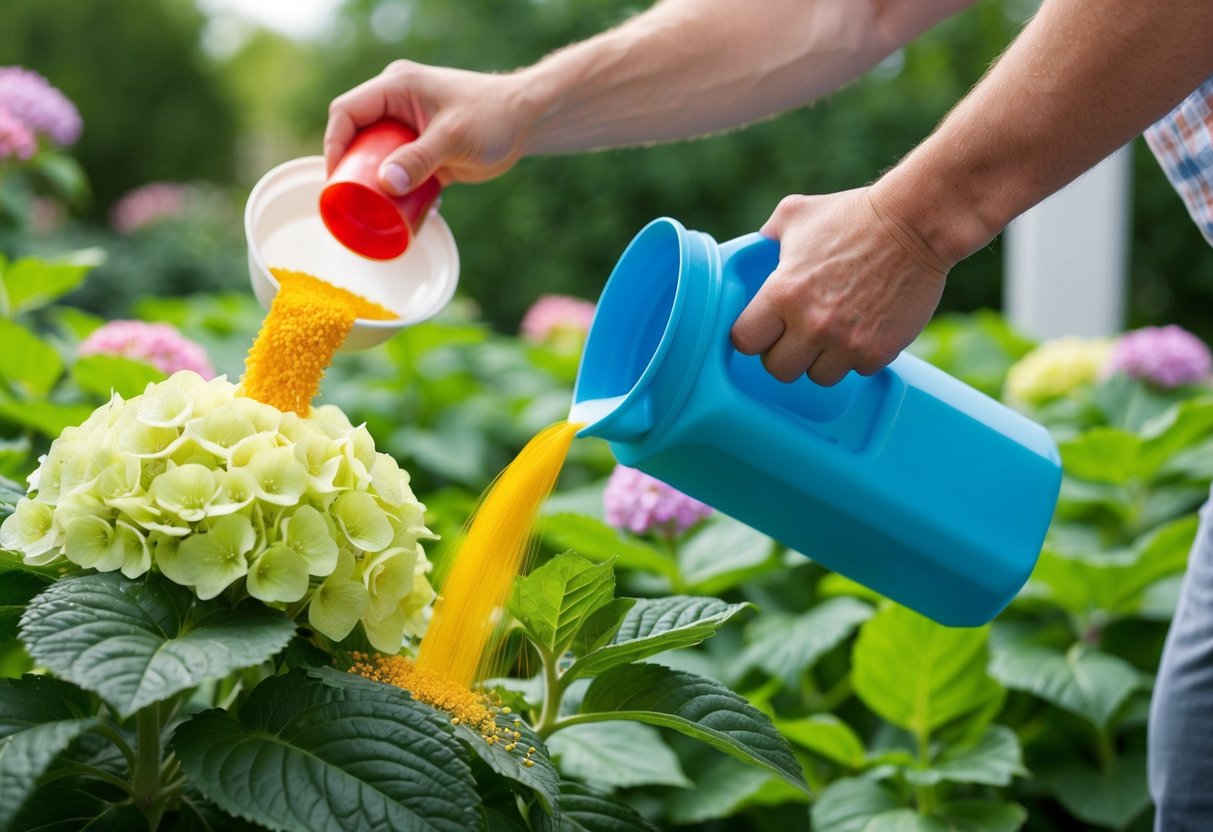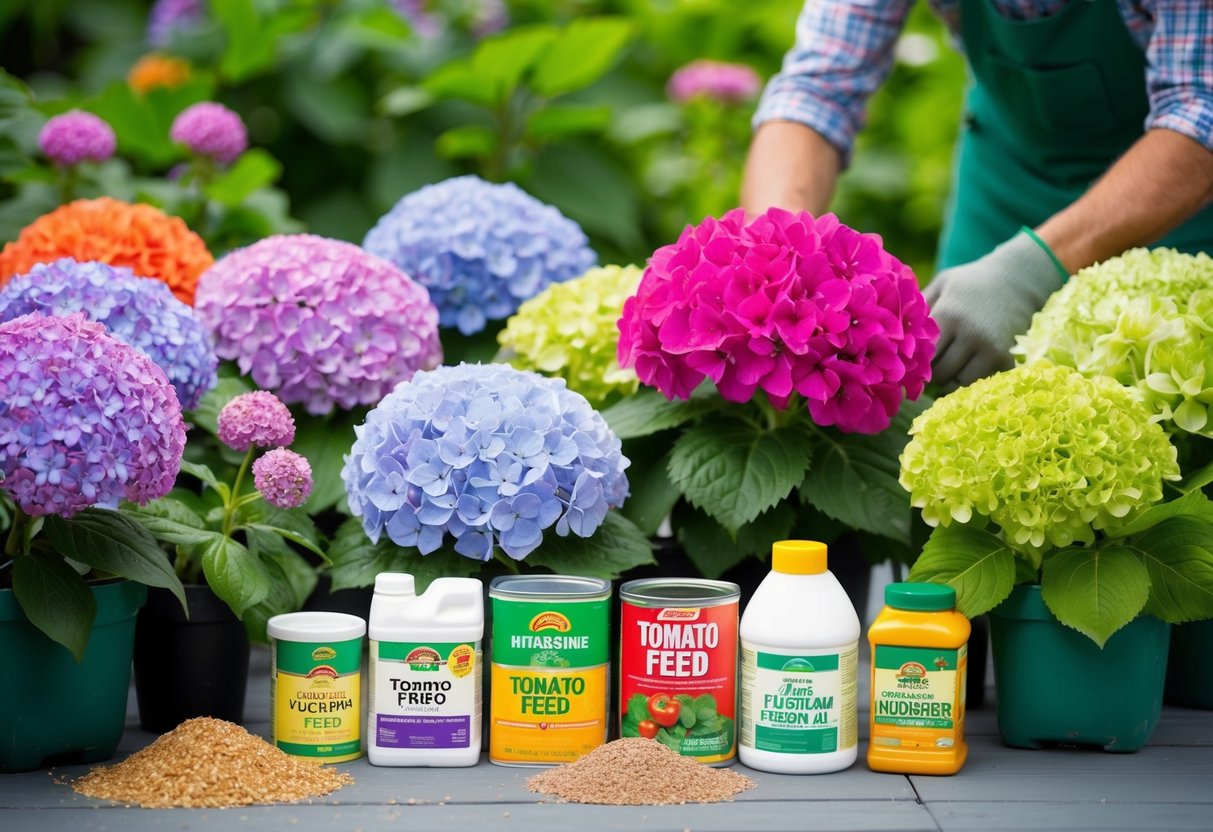Can I Feed Hydrangeas with Tomato Feed? Tips and Advice
If you’re a gardening enthusiast, you might wonder if the tomato feed in your shed could also nurture your hydrangeas. It’s a common thought, especially if you’re striving to make your garden both beautiful and efficient. However, using tomato feed on hydrangeas is not recommended because the nutrient needs of these plants differ.

Hydrangeas flourish with balanced fertilizers that cater to their specific requirements. Tomato feed is usually rich in phosphorus, designed to boost fruit production, but hydrangeas thrive on a different nutrient mix. Overusing a tomato-based formula can lead to lush foliage at the expense of those breathtaking blooms.
When you choose the right food for your hydrangeas, you’re giving them the best chance to thrive and produce those show-stopping flowers. Considering their need for a blend of nutrients, you’ll find that specially designed hydrangea fertilizers will better support their growth and beauty. To explore this topic further, Fertilize Hydrangeas Like a Pro offers essential tips for getting it just right.
Understanding Hydrangea Nutrition

Hydrangeas require specific nutrients to thrive and show vibrant blooms. Balancing these nutrients with the right soil pH can significantly impact how well your plants grow and flower.
Essential Nutrients for Hydrangeas
To ensure healthy hydrangea growth, you need to focus on three main nutrients: nitrogen (N), phosphorus (P), and potassium (K). These are key components of hydrangea fertilizer. Nitrogen helps with leaf development, while phosphorus is important for strong roots and vibrant blooming. Potassium supports overall plant health and resilience.
For the best results, consider using a balanced 10-10-10 fertilizer or one with higher phosphorus, such as 15-30-15. These fertilizers provide a more tailored nutrient mix for hydrangeas. Adding organic matter like compost can also improve soil structure and nutrient retention.
Soil pH and Nutrient Absorption
Soil pH plays a crucial role in how hydrangeas absorb nutrients. Most hydrangeas prefer slightly acidic soil for optimal growth. In acidic conditions, nutrients are more available to the plant, especially when it comes to color-changing varieties that rely on aluminum uptake.
You can adjust soil pH using materials like aluminum sulfate to create more acidic conditions, or lime to make it more alkaline. These changes affect not just nutrient uptake, but also the color of hydrangea blooms. Maintaining the right balance ensures your hydrangeas get the nutrients they need for beautiful blooms and healthy foliage.
The Role of Tomato Feed in Hydrangea Care

When caring for hydrangeas, choosing the right fertilizer is crucial. Tomato feed, with its unique formulation, might seem like a good option. Understanding how it compares to dedicated hydrangea fertilizers, and considering its potential benefits and drawbacks, will help you make an informed decision.
Comparing Tomato Feed to Hydrangea Fertilizers
Tomato feed is specifically designed to promote fruit production in tomatoes. It typically has a higher potassium content and a more tailored N-P-K ratio that supports fruit growth. This makes it different from what hydrangeas need. For hydrangeas, balanced fertilizers like a 10-10-10 formula work well, as they provide equal parts of nitrogen, phosphorus, and potassium.
Hydrangeas thrive when they’re given fertilizers with higher phosphorus content, such as a 15-30-15 mix. This supports their flowering, which is a key characteristic. Tomato feed’s focus on potassium means it might not provide enough phosphorus for hydrangeas. Consider using slow-release or organic fertilizers meant specifically for flowering plants to achieve the best results.
Potential Benefits and Drawbacks
While tomato feed might not be the first choice, it could still have some use in hydrangea care under certain conditions. Its potassium-rich formula can enhance bloom color in some plant varieties. If you already have tomato feed and your hydrangeas aren’t flowering well, experimenting cautiously with small amounts might show results.
On the flip side, overusing tomato feed can lead to fertilizer burn, affecting your plant’s health. Additionally, chemical fertilizers, like many tomato feeds, might not be ideal if you’re aiming for organic gardening. Always monitor nutrient levels to avoid any negative impact on your hydrangeas.
Practical Hydrangea Feeding Tips

When it comes to feeding hydrangeas, a well-organized routine and understanding the seasonal needs of the plants are crucial. Using different methods like compost, slow-release fertilizers, and careful timing can enhance growth and blooming.
Creating an Effective Feeding Schedule
Plan your feeding schedule to support your hydrangeas throughout the growing season. Start with a balanced 10-10-10 fertilizer or compost in early spring when new leaves begin to appear. This helps wake them from dormancy. In late spring, using a phosphorus-rich fertilizer improves bloom production.
Applying slow-release fertilizers involves spreading them around the base of the plant to gradually nourish it. Be careful with the application, making sure the fertilizer doesn’t touch the leaves to prevent burning. Regular feeding every 6-8 weeks can keep your plants healthy and thriving.
Seasonal Considerations for Hydrangea Nutrition
The nutritional needs of hydrangeas change with the seasons. In fall and winter, they need different care to prepare for cold weather. Compost or peat moss can be applied in autumn to blanket roots and offer winter protection. Avoid overfeeding during this time to prevent new growth that can get damaged by frost.
Consider using lime if you want to adjust the soil pH, which can affect bloom color. Blue hydrangeas benefit from acidic soil, while pink ones prefer a more neutral pH. Adjusting these soil conditions is best done in early autumn so changes can take effect during dormancy.
Common Issues and Solutions

Caring for hydrangeas can come with a few challenges. Whether it’s getting the leaves to look healthy or achieving your desired bloom color, there are solutions that can help your plants thrive.
Dealing with Yellowing Leaves and Stunted Growth
Yellowing leaves on hydrangeas could be a sign of iron deficiency or root rot. To tackle this, check the soil drainage. Ensure it’s well-drained to prevent water from sitting at the roots, causing rot. You can improve drainage by adding sand or compost to the soil.
Iron deficiency might be another culprit. Adding iron-rich fertilizers or adjusting the soil pH to be more acidic can help. Use a balanced fertilizer with a 10-10-10 nitrogen-phosphorus-potassium (NPK) ratio to support your plant’s health. Regular monitoring of the hydrangea’s condition is crucial to ensure they grow strong.
Adjusting Hydrangea Bloom Colors
The color of hydrangea blooms can be influenced by soil pH. If you want vibrant blooms in shades of blue, aim for a more acidic soil pH between 5.2 and 5.5. This can be achieved by adding elemental sulfur or aluminum sulfate to the soil.
Conversely, for pink blooms, create a more alkaline environment. Adding lime to the soil can increase the pH, resulting in pink or even red blooms. Regular testing of soil pH can help you maintain these conditions. Making these soil amendments will guide your hydrangeas to bloom in your favorite colors.
Caring for Different Types of Hydrangeas

When looking after hydrangeas, it’s important to know the unique needs of each variety. While hydrangeas generally need good soil, regular watering, and the right amount of sunlight, each type has specific requirements to thrive.
Special Considerations for Various Hydrangea Varieties
Smooth Hydrangeas
Smooth hydrangeas prefer a bit of morning sun but can handle some shade later in the day. They do well in soil with plenty of organic matter, so mix in compost when planting. You’ll also need to make sure to prune them. Cut back the stems in late winter for a burst of new growth.
Blue Hydrangeas
Blue hydrangeas need acidic soil to maintain their color. You might want to use a fertilizer specifically designed for acid-loving plants. These plants love sunlight but keep them shielded from the harsh afternoon sun. Regular watering is key, especially during dry spells.







